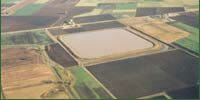
Farm Dams for the Sugar Industry
(Watts, PJ, Cox, GJ and Stepnuk, LM. March 2001)
There is no set recipe for building a farm dam, as site-specifics vary the procedure in each case. Such a project is typically undertaken by a team consisting of the farmer(s), an experienced consultant and a contractor. However, some duties performed by the consulting engineer can be carried out by an extension officer and/or the farmer, since the basic steps remain the same for dam feasibility analysis, design and maintenance. These Guidelines serve to illustrate the methods and tasks involved in these steps.
- Chapter 1 rationale for building a farm dam. (24 kb)
- Chapter 2 investigations prior to on-site inspection (445 kb)
- Chapter 3 site inspection (526 kb)
- Chapter 4 discusses considerations in detailed design. (1151 kb)
- Chapter 5 examines construction practices specific to earth dams. (510 kb)
- Chapter 6 delineates maintenance requirements. (819 kb)
The appendices provide background information for dam options:
- Appendix A - dam options (1486 kb)
- Appendix B - legal and safety issues (495 kb)
- Appendix C - climatic data (220 kb)
- Appendix D - catchment yield (34 kb)
- Appendix E - soil classification, testing and suitability (380 kb)
- Appendix F - dams as ecosystems (1054 kb)
Farm Dams for the Sugar Industry has been compiled by FSA Irrigation, and was funded by the Rural Water Use Efficiency Scheme, the Bureau of Sugar Experiment Stations and Bundaberg Sugar Ltd.

Assessment of evaporation mitigation systems
Craig et al, (2005) and Watts (2005) identified a number of areas for further research and investment in this area of evaporation. One of these was the development of a computer model (?Ready Reckoner?) that would allow site-specific assessment of evaporation mitigation systems. Evaporation mitigation systems (EMS?s) include installing a cover over the water, applying a chemical monolayer or modifying the shape of the storage dam. For example, increasing the storage depth reduces the relative surface area of the volume of water stored, hence reducing evaporative losses.
The ?Ready Reckoner? is a model developed by FSA Consulting and NCEA that performs a simple, site-specific economic assessment of the viability of evaporation mitigation systems. The user enters appropriate data to customise the ?Ready Reckoner? to their site. The ?Ready Reckoner? returns the volume of water saved (in ML) and the cost of the evaporation mitigation system used to save this water ($/ML/year). The ?Ready Reckoner? can be found at: http://www.npsi.gov.au/readyreckoner/index.html
- Download Manual [PDF]
- Download Spreadsheet [XLS]

Effective evaporation reduction systems
Over the past few years there has been a number of investigations into effective evaporation reduction systems. According to a Scoping Study commissioned by NPSI in 2005, such systems need to:
- reduce the amount of energy available to cause evaporation,
- restrict the boundary layer at the water surface, or
- modify the wind and humidity above the water surface.
Current evaporation programs include chemical monolayers, floating vegetation, assorted floating modular devices, air-tight surface covers, and shade-cloth. FSA Consulting did a Scoping Study on Reduction of Evaporation from Farm Dams. Further information on the findings from this scoping study can be accessed from the Knowledge Base on the NPSI website ?Scoping Study: Reduction of Evaporation from Farm Dams? Dr. Peter J. Watts; www.npsi.gov.au or downloaded here.
- NPSI Farm Dam Evaporation [PDF]
|

